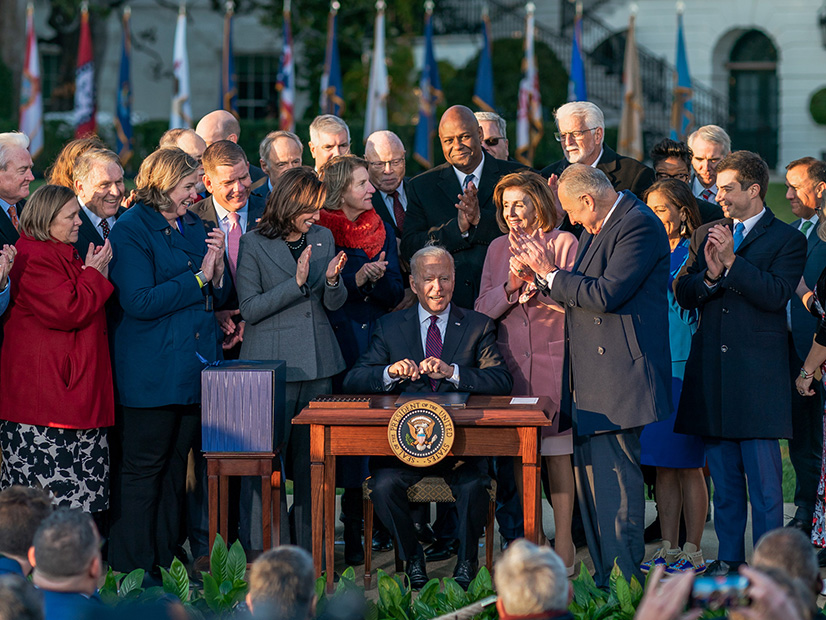
Six New York utilities have indicated they will apply for roughly $900 million in federal loans and grants made available from the Infrastructure Investment and Jobs Act (IIJA) and Inflation Reduction Act (IRA) (22-M-0149).
The utilities are acting in response to Feb. 27 letters sent by the state’s Public Service Commission, which directed them to seek IIJA and IRA funds to support clean energy investments. (See Biden Signs $1.2 Trillion Infrastructure Bill.)
In the letters, PSC Chair Rory Christian wrote that he “views these federal programs as a singular opportunity to reduce costs to New York ratepayers, make critical reliability and resiliency investments in the electric grid, and further the attainment of the state’s energy policies as outlined in the state’s climate law.”
The PSC sent the letters to Orange & Rockland (O&R), Central Hudson Gas & Electric, Long Island Power Authority (LIPA), Consolidated Edison (ConEd), National Grid, New York State Electric and Gas and Rochester Gas & Electric (NYSEG/RG&E), and National Fuel Gas Distribution Corporation.
In responses submitted March 24-27 National Grid (NYSE: NGG), ConEd (NYSE: ED), ConEd subsidiary O&R, NYSEG/RG&E and Central Hudson said they will collectively be pursuing hundreds of millions in U.S. Department of Energy loans or grants for enhancing the future grid, energy storage development, and resiliency upgrades.
National Fuel (NYSE: NFG) said it would not tap into DOE funds, since as “a gas-only utility” it does “not currently have any fully developed projects that would be eligible for federal funding,” but confirmed its was investigating hydrogen opportunities, which may be eligible in the future.
LIPA had yet to submit a response as of Monday.
The National Grid and Central Hudson letters included project spending plans, while the other three confirming utilities redacted much of that information, citing confidentiality, although they did briefly dive into monetary estimates.
ConEd anticipates “pursuing approximately $244 million in DOE funding;” O&R, about $125 million. NYSEG and RG&E will be jointly applying for $260 million.
Those utilities all plan to apply for funds from the Preventing Outages and Enhancing the Resilience of the Electric Grid program, while ConEd and O&R will apply to both the Smart Grid Investment Matching Grant and Long Duration Energy Storage Demonstration Initiative and Joint programs. ConEd and NYSEG/RG&E will also seek to tap the Clean Hydrogen Hubs program.
National Grid anticipates applying for $50 million from the Increase Capacity & Enhance Flexibility program for its “Future Grid” project, which the utility says will allow it “to deploy digital technology solutions to maximize the value of third-party distributed energy resources for customers.”
Additionally, the utility is applying for $200 million through the Preventing Outages and Enhancing the Resilience of the Electric Grid program, with $100 million to be invested into energy storage facilities in rural northeast New York around Ticonderoga and another $100 million spent on “weatherization of existing grid structures in eastern and western New York State and the hardening of existing infrastructure to improve resilience and speed of recovery in the face of climate change.”
National Grid said Ticonderoga “often experiences electrical outages,” so it proposes three battery storage systems be developed in the area to “improve reliability by carrying the energy load until crews arrive to make the necessary repairs.”
Central Hudson seeks roughly $8 million for the rehabilitation of two hydroelectric projects: the Dashville Dam and the Sturgeon Pool Hydroelectric Plant, which would be funded through the Hydroelectric Efficiency Improvement Incentive and the Maintaining & Enhancing Hydroelectricity Incentive, respectively.
The Public Utility Law Project on March 15 submitted a letter to the DOE in support of the New York utilities, saying “every dollar received from these funds can lower the revenue requirement impact on ratepayers.”
The DOE’s Loan Program Office has outlined processes to apply for IIJA and IRA loans or grants and some programs have started accepting applications.

